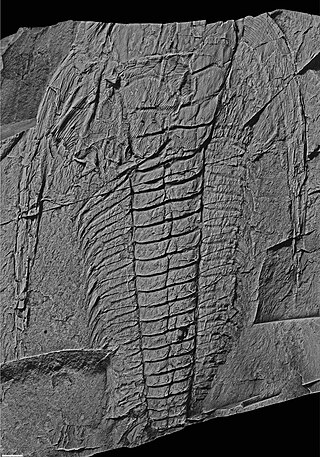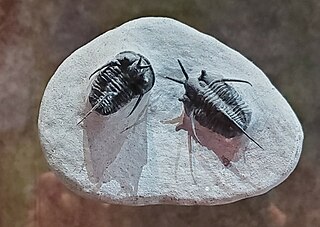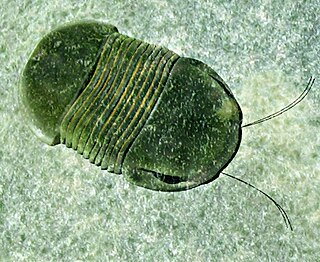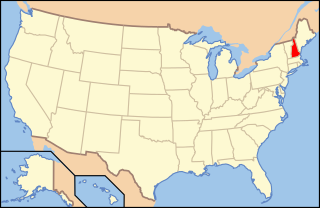
The Devonian is a geologic period and system of the Paleozoic era during the Phanerozoic eon, spanning 60.3 million years from the end of the preceding Silurian period at 419.2 million years ago (Ma), to the beginning of the succeeding Carboniferous period at 358.9 Ma. It is named after Devon, South West England, where rocks from this period were first studied.
The PaleozoicEra is the first of three geological eras of the Phanerozoic Eon. Beginning 538.8 million years ago (Ma), it succeeds the Neoproterozoic and ends 251.9 Ma at the start of the Mesozoic Era. The Paleozoic is subdivided into six geologic periods :

The Silurian is a geologic period and system spanning 24.6 million years from the end of the Ordovician Period, at 443.8 million years ago (Mya), to the beginning of the Devonian Period, 419.2 Mya. The Silurian is the shortest period of the Paleozoic Era. As with other geologic periods, the rock beds that define the period's start and end are well identified, but the exact dates are uncertain by a few million years. The base of the Silurian is set at a series of major Ordovician–Silurian extinction events when up to 60% of marine genera were wiped out.

Trilobites are extinct marine arthropods that form the class Trilobita. Trilobites form one of the earliest known groups of arthropods. The first appearance of trilobites in the fossil record defines the base of the Atdabanian stage of the Early Cambrian period and they flourished throughout the lower Paleozoic before slipping into a long decline, when, during the Devonian, all trilobite orders except the Proetida died out. The last trilobites disappeared in the mass extinction at the end of the Permian about 251.9 million years ago. Trilobites were among the most successful of all early animals, existing in oceans for almost 270 million years, with over 22,000 species having been described.

Pterygotus is a genus of giant predatory eurypterid, a group of extinct aquatic arthropods. Fossils of Pterygotus have been discovered in deposits ranging in age from Middle Silurian to Late Devonian, and have been referred to several different species. Fossils have been recovered from four continents; Australia, Europe, North America and South America, which indicates that Pterygotus might have had a nearly cosmopolitan (worldwide) distribution. The type species, P. anglicus, was described by Swiss naturalist Louis Agassiz in 1839, who gave it the name Pterygotus, meaning "winged one". Agassiz mistakenly believed the remains were of a giant fish; he would only realize the mistake five years later in 1844.

John William Salter was an English naturalist, geologist, and palaeontologist.

Gravicalymene Shirley, 1936, is a genus of trilobites belonging to the order Phacopida, suborder Calymenina and family Calymenidae. Species included in this genus have previously been allocated to Calymene Brongniart 1822,Flexicalymene Shirley, 1936. and Sthenarocalymene Siveter 1977.

Cyphaspis is a genus of small trilobite that lived from the Late Ordovician to the Late Devonian. Fossils have been found in marine strata in what is now Europe, Africa and North America. Various species had a compact body, and a large, bulbous glabellum. Many species had long spines arranged similarly to closely related genera, such as Otarian, Otarionella, Chamaeleoaspis, and Namuropyge.

Acastoides is an extinct genus of trilobite that lived during the Silurian and Devonian. It has been found in Bolivia, France, Morocco, Poland, Turkey and the United Kingdom.

Aulacopleura is a genus of proetid trilobite that lived from the Middle Ordovician to the Middle Devonian. Some authors may classify this group as subgenus Otarion (Aulacopleura). The cephalon is semicircular or semielliptical, with border and preglabellar field. The glabella is short, with or without defined eye ridges connecting it with eyes of variable size. Spines at the rear outer corners of the cephalon are present, typically reaching back to the 2nd to 4th thorax segment. The 'palate' is not connected to the dorsal shield of the cephalon. The cephalon is pitted, or has small tubercles. The thorax has up to 22 segments. The pleural ends are usually rounded. The pygidium is small (micropygous), with an even margin. A. koninckii had a modern type of compound eye.

Bumastus is an extinct genus of corynexochid trilobites which existed from the Early Ordovician period to the Late Silurian period. They were relatively large trilobites, reaching a length of 6 in (15 cm). They were distinctive for their highly globular, smooth-surfaced exoskeleton. They possessed well-developed, large compound eyes and were believed to have dwelled in shallow-water sediments in life.

Paleontology in Ohio refers to paleontological research occurring within or conducted by people from the U.S. state of Ohio. Ohio is well known for having a great quantity and diversity of fossils preserved in its rocks. The state's fossil record begins early in the Paleozoic era, during the Cambrian period. Ohio was generally covered by seawater from that time on through the rest of the early Paleozoic. Local invertebrates included brachiopods, cephalopods, coral, graptolites, and trilobites. Vertebrates included bony fishes and sharks. The first land plants in the state grew during the Devonian. During the Carboniferous, Ohio became a more terrestrial environment with an increased diversity of plants that formed expansive swampy deltas. Amphibians and reptiles began to inhabit the state at this time, and remained present into the ensuing Permian. A gap in the local rock record spans from this point until the start of the Pleistocene. During the Ice Age, Ohio was home to giant beavers, humans, mammoths, and mastodons. Paleo-Indians collected fossils that were later incorporated into their mounds. Ohio has been the birthplace of many world famous paleontologists, like Charles Schuchert. Many significant fossils curated by museums in Europe and the United States were found in Ohio. Major local fossil discoveries include the 1965 discovery of more than 50,000 Devonian fish fossils in Cuyahoga County. The Ordovician trilobite Isotelus maximus is the Ohio state invertebrate fossil.

Paleontology in Illinois refers to paleontological research occurring within or conducted by people from the U.S. state of Illinois. Scientists have found that Illinois was covered by a sea during the Paleozoic Era. Over time this sea was inhabited by animals including brachiopods, clams, corals, crinoids, sea snails, sponges, and trilobites.

Paleontology in South Carolina refers to paleontological research occurring within or conducted by people from the U.S. state of South Carolina. Evidence suggests that at least part of South Carolina was covered by a warm, shallow sea and inhabited by trilobites during the Cambrian period. Other than this, little is known about the earliest prehistory of South Carolina because the Ordovician, Silurian, Devonian, Carboniferous, Permian, Triassic, and Jurassic, are missing from the state's local rock record. The earliest fossils of South Carolina date back to the Cretaceous, when the state was partially covered by seawater. Contemporary fossils include marine invertebrates and the remains of dinosaur carcasses that washed out to sea. On land, a wide variety of trees grew. Sea levels rose and fell throughout the ensuing Cenozoic era. Local marine life included invertebrates, fish, sharks, whales. The first scientifically accurate identification of vertebrate fossils in North America occurred in South Carolina. In 1725, African slaves digging in a swamp uncovered mammoth teeth, which they recognized as originating from an elephant-like animal.

Paleontology in New York refers to paleontological research occurring within or conducted by people from the U.S. state of New York. New York has a very rich fossil record, especially from the Devonian. However, a gap in this record spans most of the Mesozoic and early Cenozoic.

Paleontology in Vermont comprises paleontological research occurring within or conducted by people from the U.S. state of Vermont. Fossils are generally uncommon in Vermont. Nevertheless, however, significant finds have been made in the state. Very few fossils are known in Vermont east of the Green Mountains due to the type of rock underlying that area. During the early part of the Paleozoic era, Vermont was covered by a warm, shallow sea that would end up being home to creatures like brachiopods, corals, crinoids, ostracoderms, and trilobites. There are no rocks in the state from the Carboniferous, Permian, Triassic, or Jurassic periods. The few Cretaceous rocks present contain no fossils. The Paleogene and Neogene periods are also absent from the local rock record. During the Ice Age, glaciers scoured the state. At times the state was inundated by seawater, allowing marine mammals to venture in. After the seawater drained away the state was home to mastodons. Local fossils had already attracted scientific attention by the mid-19th century when mastodon remains were found in Rutland County. In 1950 a major Paleozoic invertebrate find occurred. The Pleistocene Beluga whale Delphinapterus leucas is the Vermont state fossil.

Paleontology in New Hampshire refers to paleontological research occurring within or conducted by people from the U.S. state of New Hampshire. Fossils are very rare in New Hampshire because so much of the state's geology is highly metamorphic. The state's complicated geologic history has made dating its rocks and the fossils they contain "a difficult task." The state's Devonian rocks are especially metamorphosed, yet its Mississippian rocks formed too recently to have been subject to the same metamorphism. Nevertheless, despite the geologic complications some fossils have been discovered in the state.

Paleontology in Wisconsin refers to paleontological research occurring within or conducted by people from the U.S. state of Wisconsin. The state has fossils from the Precambrian, much of the Paleozoic, some a parts of the Mesozoic and the later part of the Cenozoic. Most of the Paleozoic rocks are marine in origin. Because of the thick blanket of Pleistocene glacial sediment that covers the rock strata in most of the state, Wisconsin’s fossil record is relatively sparse. In spite of this, certain Wisconsin paleontological occurrences provide exceptional insights concerning the history and diversity of life on Earth.

Odontopleura is a genus of spinose odontopleurid trilobite in the family Odontopleuridae, and is the type genus of that family and of Odontopleurida. The various species are found in Upper Ordovician to Middle Devonian marine strata throughout the world. The best studied fossils are of the type species, O. ovata, from the Wenlock-aged Liteň Formation in Loděnice, in Bohemia, Czech Republic, and, southeastern Gotland, of Sweden.
Dudleyaspis is an extinct genus of Lower to Middle Devonian odontopleurid trilobites that lived in a shallow sea that lay between Euramerica and Gondwana. It was named in 1949 by Prantl & Pribyl.


















